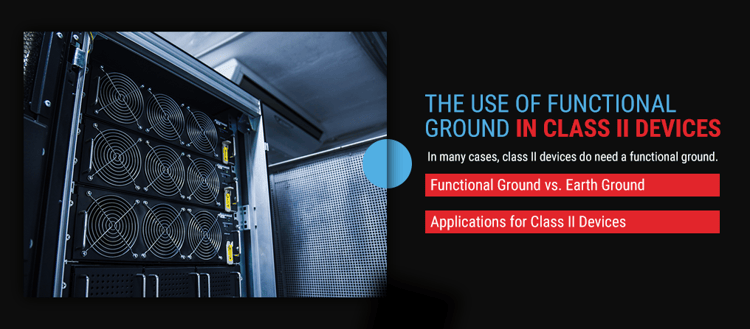RESOURCES
Functional Ground and Protection Classes in Power Supplies
When you're selecting a power supply, you have many specifications and requirements to keep in mind. In particular, you'll need to consider the protection class you need and if a functional ground may be needed to mitigate electromagnetic interference (EMI). In this guide, we'll discuss the International Electrotechnical Commission (IEC) protection classes and explain how they differ from one another. We'll also elaborate on how functional grounding differs from earth grounding and what implications it has for electrical devices, particularly in medical markets.
IEC PROTECTION CLASSES
The IEC has established three protection classes for electronic equipment: class I, class II and class III. In this guide, we'll primarily discuss classes I and II, which both provide user protection from electric shock.
IEC classes I and II prevent electric shock by including two types of protection. They may provide protection from hazardous voltage with one or more types of insulation systems. A basic insulation system and a reinforced insulation system. Basic insulation is One means of protection, while reinforced insulation is an enhanced insulation system equivalent to double basic insulation. In addition to insulation, a protective earth connection is provided for diverting fault energy if should there be an accidental breakdown of the basic insulation. Having two types of protection offers a backup. The second level protects the user if the voltage level becomes so hazardous that the first level fails. In class III, the input connects to a safety extra-low voltage (SELV) circuit, after which no extra protection is necessary.
A protective earth connection, earth ground or safety ground uses a protective conductor to direct a fault current safely into the earth and away from a human being in contact. It also has a protective device — a fuse or circuit breaker — to interrupt electric current to a faulty circuit. Insulation, on the other hand, typically uses plastic as an isolation barrier to help keep an electric current safely in its proper circuit and prevent leakage without requiring this ground connection.
The success of each of these systems is dependent on isolation voltage — a test voltage used to assess the integrity of the insulation. . Most insulators have very high impedance, hence they can block current flow. However, when the voltage across the insulation system becomes high enough, and if the stress of the voltage lasts long enough, it can break down the insulation, potentially causing an electric shock to the person in contact. Hence, insulation systems must have sufficient withstanding integrity, or dielectric withstanding voltage, to ensure it continues to maintain its insulation properties forever.
CLASS I
What is IEC Class I?
IEC class I protects against electric shock through a combination of a safety earth ground and basic insulation. A class I appliance has a conductive chassis connected to protective earth ground. These appliances must have a 3-wire safety approved power cord that contains a protective earth ground conductor. This earth wire is bonded or bolted to the sheet metal of the appliance. T Instead of passing it to the person in contact with the appliance. Electrosurgical units, blood pressure catheters, and electrocardiogram (ECG) systems are often class I equipment.
CLASS II
What is IEC Class II?
IEC Class II power supply protection prevents electric shock through two levels of insulation: basic insulation and supplementary insulation. An example of basic insulation is the single layer of plastic insulation that wraps around the conductor of a power cord and protects the user from shock under normal conditions. An example of supplementary insulation is a second layer that protects users from dangerous voltage levels if the basic layer cannot do so. In a device with a hard plastic case, for example, the protective case is usually the supplementary insulation.
Class II devices must have an enhanced insulation system, also called Reinforced insulation. The reinforced insulation system may be composed of two layers of Basic insulation or One layer thick and strong enough to be equivalent to two basic layers. Since it is equal to two layers of basic insulation, it is also called double insulation. Class II devices do not need a protective earth ground A class II appliances use a two-wire power cord, hence do not have the means to connect the appliance enclosure to protective earth. Since a physical protective earth ground connection is missing, Class II appliances need double or reinforced insulation. Medical power adapters intended for home health care equipment are often class II devices, in fact, to meet IEC60601-1-11 a home healthcare power supply has to be of Class II type and operate with a 2-wire power cord.

THE USE OF FUNCTIONAL GROUND IN CLASS II DEVICES
DO CLASS II DEVICES HAVE FUNCTIONAL GROUND?
In some cases, class II devices may have a functional ground. Though class II devices do not require a protective earth ground, they do sometimes require a functional ground for electromagnetic compatibility (EMC). As with protective earth grounds, a transformer blocks the power current from flowing to earth but allows any transient current or leakage to flow to the ground.
FUNCTIONAL GROUND VS. EARTH GROUND
Difference Between Functional Ground & Earth Ground
A functional ground differs from protective earth ground in that it does not offer shock protection from a hazardous voltage. However, it does help to mitigate electromagnetic noise or EMI. This protection can be of paramount importance in the medical market. A functional ground mitigates EMI Ensuring the devices operate well without interfering with nearby electronic equipment.
What is the importance of functional ground vs. earth ground for medical devices? Although medical equipment may not require an earth ground, it may require a functional ground to reduce EMI. A functional ground helps ensure the high performance of critical class II medical devices even in a clinical environment that contains radio transmitters, radio frequency wireless devices and equipment like MRI and CT scanners.
In class II medical device isolation, the device does not need a safety connection to an earth ground because its double insulation means users will not come into contact with any of the live parts. Recall that a class II appliance cannot connect to a protective ground because of the double insulation required between the accessible parts and live parts. However, class II equipment may need a functional ground for EMI and noise reduction and circuit completion. Class II medical device ground requirements may mandate the device to be tied to a functional ground for EMC reasons.
APPLICATIONS FOR CLASS II DEVICES
Many appliances designed for home use need class II protection. Medical clinics — though not hospitals — are starting to require class II, as well, for its double layer of protective insulation. Hospitals need only class I since they have grounded plugs to provide additional protection.
CONTACT ASTRODYNE TDI FOR ALL YOUR POWER SUPPLY NEEDS
Whether you need class I or class II protection for your electronic equipment, work with Astrodyne TDI's experts to find the perfect solution. We offer a variety of power supplies to meet your grounding and isolation needs and our quality EMI filters can help your facility achieve and maintain EMC.
At Astrodyne TDI, we have extensive experience in working with customers’ specific certification requirements, so we can help you navigate class I protective earth ground requirements, class II functional ground requirements and help you to meet the challenging requirements of electrical medical equipment. If you need a custom solution, we are happy to work with you to help you meet your power needs.
Contact us today to learn more.


